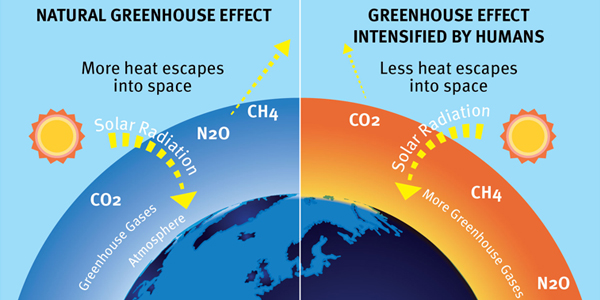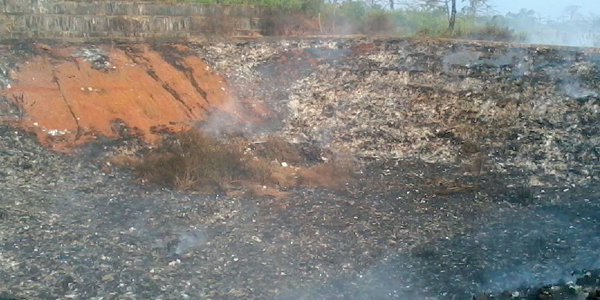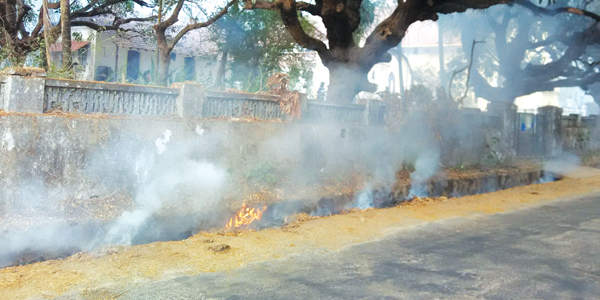Demystifying Climate Change
Introduction
It is often thought that 'climate' and 'weather' are the same, or are interchangeable. There is a difference though, and it relates to a measure in time. Weather refers to conditions of the atmosphere over a short period of time (typically a few hours or days), and climate is how the atmosphere behaves or changes over a relatively long period of time such as 30 years or so.
What is 'climate change'?
Climate change involves significant changes in the climate system over time periods ranging from decades to millions of years. A scientist studying climate change generally combines evidences from temperature and rainfall measurements, satellite soundings and climate model experiments. The main driver that leads to climate change is the increase in greenhouse gases (GHG) that cause global warming. This increase in the GHG concentration could be based on natural or human induced factors.
Natural climate change
Natural changes in the Earth's orbit which may occur over time scales of thousands of years, or changes occurring in the sun and affecting the amount of incoming solar radiation can cause climate change. Further, large-scale volcanic eruptions which eject large amounts of ash into the atmosphere can also induce changes as the ash may remain in the atmosphere for several months or years, and hence reflect sunlight back into space, resulting in a drop of mean global surface temperature.
Anthropogenic (human-induced) climate change
The Earth's atmosphere contains a layer of GHGs, namely water vapour, ozone, carbon dioxide, methane, nitric oxide, nitrous oxide, hydrocarbons and chlorofluorocarbons. When the Sun's radiation enters the Earth's atmosphere, a fraction of it is trapped by the GHGs present in the atmosphere and the rest is reflected back to space. The trapped GHGs maintain the temperature of the Earth's atmosphere making our planet habitable and allowing for life to thrive, unlike other planets in our solar system. However, the problem is that human activity is altering this natural balance, giving rise to an Enhanced Greenhouse Effect.
The anthropogenic (man-made) causes include burning of fossil fuels, burning/decays from landfills and mining, industrial and vehicular emissions. Since industrialization, the global greenhouse gas emissions have increased manifold. As per the latest data, the current carbon dioxide levels in the atmosphere have crossed the 400 ppm (parts per million) mark. These man-made causes accelerate the process of global warming, and thus - climate change.
Since climate change is a global issue, we all are into it together. While there are international negotiations going on for collective action to reduce emissions, concerted actions at local level in Goa are also equally needed. At the national level, India has been a party to the international deliberations and has come out with a National Action Plan on Climate Change (NAPCC). At the state level, Goa is also in the process of coming up with the state action plan on climate change and forming a steering committee to decide on the local adaptation strategies to combat climate change impacts. Sectoral impacts of climate change shall be covered in the next part of this article.


Burning of Mixed Waste

Burning of Biomass
CHRONOLOGY OF INTERNATIONAL NEGOTIATIONS ON COMBATING CLIMATE CHANGE
- 1979: The first World Climate Conference held
- 1988: The Intergovernmental Panel on Climate Change (IPCC) was established
- 1990: The IPCC and the second World Climate Conference call for a global treaty on CC
- 1991: First meeting of the Intergovernmental Negotiating Committee held
- 1992: At the Earth Summit in Rio, the United Nations Framework Convention of Climate Change (UNFCCC) is opened for signature along with its sister Rio Conventions, the UN Convention on Biological Diversity and the UN Convention to Combat Desertification
- 1994: The UNFCCC enters into force
- 1995: The first Conference of Parties (COP1) held in Berlin
- 1996: The UNFCCC Secretariat is set up to support action under the Convention
- 1997: The Kyoto Protocol is formally adopted at COP3. The protocol legally binds countries to emission reduction targets
- 2001: The Marrakesh Accords adopted at COP7, detailing the rules for implementation of the Kyoto Protocol, setting up new funding and planning instruments for adaptation, and establishing a technology transfer framework
- 2005: The first meeting of the Parties to the Kyoto Protocol (MOP1) held in Montreal
- 2007: The IPCC's Fourth Assessment Report released. At COP13, Parties agreed on the Bali Roadmap, which charted the way towards a post 2012 outcome
- 2009: Copenhagen Accord Drafted at COP15. Countries submitted emissions reductions pledges or mitigation action pledges, all non-binding
- 2010: Cacun agreements largely accepted at COP16. The largest collective effort the world has ever seen to reduce emissions in mutually accountable way
- 2011: COP17 held in Durban. Governments clearly realized the need to draw up the blueprint for a fresh universal, legal agreement to deal with CC beyond 2020
- 2012: The Doha Amendment to the Kyoto Protocol adopted. Amendments included new commitments for the period of 2013 to 2020 and a revised list of greenhouse gases to be reported
- 2013: COP19/CMP9 held. Discussions on the Green Climate Fund and long-term finance
- 2014: COP20 held in Lima, Peru
- 2015: COP21 or CMP11 held in Paris, France
